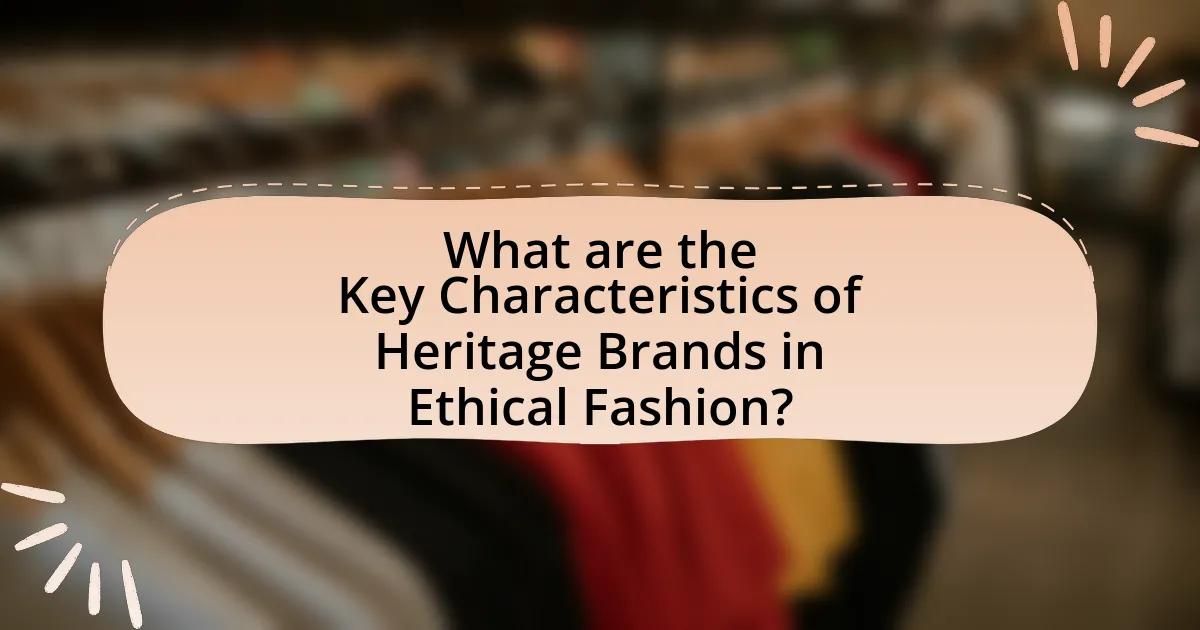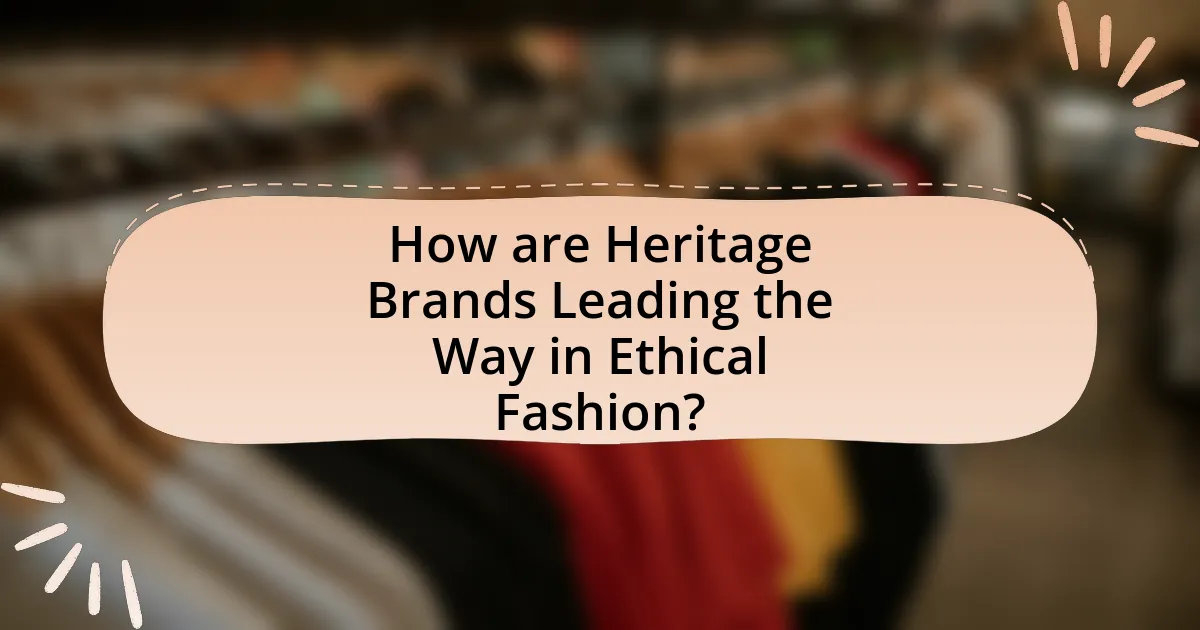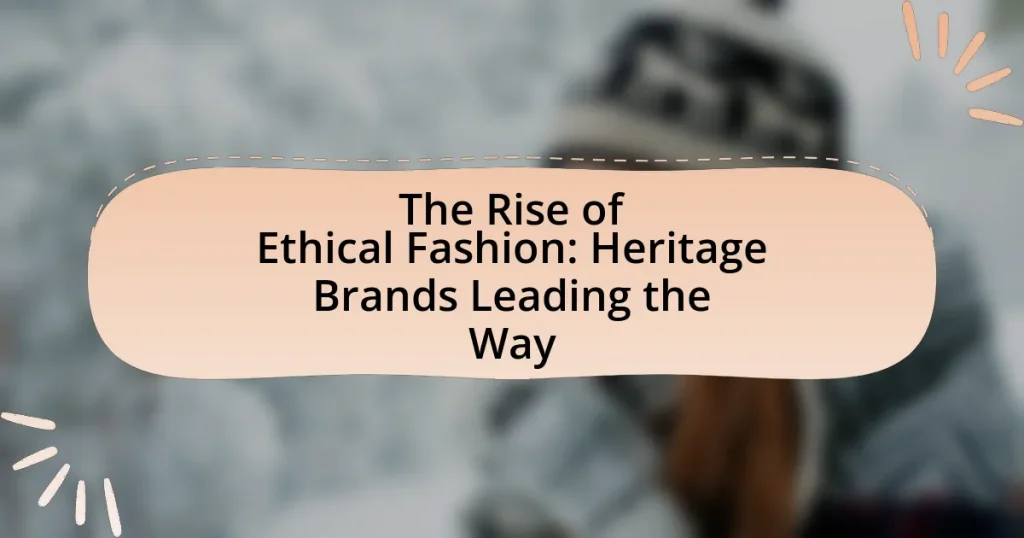The article focuses on the rise of ethical fashion, highlighting the pivotal role of heritage brands in promoting sustainable and responsible practices within the industry. It defines ethical fashion as clothing and accessories produced with a commitment to social and environmental responsibility, addressing issues such as labor rights and environmental sustainability. The article traces the evolution of ethical fashion from a niche concern to a mainstream movement, influenced by historical events and changing consumer attitudes. It emphasizes the unique advantages of heritage brands, including their established reputations and commitment to craftsmanship, while also discussing the challenges they face in adapting to modern ethical standards. Additionally, the article explores how consumers can support ethical fashion and identify truly ethical heritage brands.

What is Ethical Fashion and Why is it Important?
Ethical fashion refers to clothing and accessories produced in a manner that prioritizes social and environmental responsibility. This approach is important because it addresses issues such as labor rights, environmental sustainability, and animal welfare, promoting a more equitable and sustainable fashion industry. For instance, according to the Ethical Fashion Forum, the fashion industry is responsible for 10% of global carbon emissions, highlighting the urgent need for sustainable practices. By supporting ethical fashion, consumers can contribute to reducing these impacts and fostering fair labor practices, as seen in brands that ensure fair wages and safe working conditions for their workers.
How has the concept of ethical fashion evolved over time?
The concept of ethical fashion has evolved from a niche concern to a mainstream movement over the past few decades. Initially, ethical fashion focused primarily on labor rights and fair trade practices, with early advocates highlighting the exploitation of workers in developing countries. As awareness grew, the scope expanded to include environmental sustainability, animal welfare, and transparency in supply chains. For instance, the 1990s saw the rise of organizations like the Fair Trade Federation, which emphasized fair wages and working conditions. By the 2000s, brands began adopting sustainable materials and practices, responding to consumer demand for eco-friendly products. Recent studies indicate that over 60% of consumers now consider sustainability when making fashion purchases, reflecting a significant shift in consumer values. This evolution illustrates how ethical fashion has transitioned from a marginalized concept to a critical aspect of the global fashion industry.
What historical events have influenced the rise of ethical fashion?
The rise of ethical fashion has been significantly influenced by several historical events, including the Industrial Revolution, which led to mass production and exploitation of labor, prompting a backlash for better working conditions. The 1990s saw the emergence of the anti-sweatshop movement, driven by public outrage over labor practices in developing countries, particularly after incidents like the Rana Plaza collapse in 2013, which killed over 1,100 garment workers. Additionally, the environmental movement, particularly the 1970 Earth Day, raised awareness about the ecological impact of fashion, leading to a demand for sustainable practices. These events collectively shaped consumer awareness and advocacy for ethical standards in the fashion industry.
How do consumer attitudes towards fashion impact ethical practices?
Consumer attitudes towards fashion significantly influence ethical practices by driving demand for sustainable and responsible production methods. When consumers prioritize ethical considerations, such as environmental impact and fair labor practices, brands are compelled to adapt their practices to meet these expectations. For instance, a 2021 survey by McKinsey & Company found that 67% of consumers consider sustainability when making a purchase, prompting brands to adopt eco-friendly materials and transparent supply chains. This shift in consumer behavior not only encourages brands to implement ethical practices but also fosters a competitive market where ethical considerations become a standard expectation rather than an exception.
What role do heritage brands play in ethical fashion?
Heritage brands play a crucial role in ethical fashion by leveraging their longstanding histories and craftsmanship to promote sustainable practices. These brands often emphasize quality over quantity, which aligns with ethical fashion principles that prioritize durability and responsible consumption. For instance, brands like Patagonia and Levi’s have implemented initiatives such as using recycled materials and promoting fair labor practices, showcasing their commitment to environmental and social responsibility. This approach not only preserves traditional techniques but also educates consumers about the importance of ethical choices in fashion, thereby influencing industry standards and consumer behavior.
How do heritage brands define their commitment to ethical practices?
Heritage brands define their commitment to ethical practices through a focus on sustainability, transparency, and social responsibility. These brands often emphasize their long-standing traditions of craftsmanship and quality, which align with ethical sourcing of materials and fair labor practices. For instance, many heritage brands have adopted sustainable materials and production methods, reducing their environmental impact. Additionally, they frequently engage in transparent supply chain practices, allowing consumers to trace the origins of their products. This commitment is evidenced by initiatives such as the use of organic cotton, recycled materials, and partnerships with fair trade organizations, which collectively reinforce their ethical stance in the fashion industry.
What unique advantages do heritage brands have in promoting ethical fashion?
Heritage brands possess unique advantages in promoting ethical fashion due to their established reputation, storytelling capabilities, and commitment to craftsmanship. These brands often have a long history that fosters consumer trust, making them more credible when advocating for ethical practices. For instance, brands like Patagonia and Levi’s leverage their historical commitment to sustainability, which resonates with consumers seeking authenticity. Additionally, heritage brands can effectively communicate their values through rich narratives that highlight their ethical sourcing and production processes, further engaging consumers. This combination of trust and storytelling enhances their ability to lead in the ethical fashion movement.
Why are consumers increasingly drawn to ethical fashion?
Consumers are increasingly drawn to ethical fashion due to a growing awareness of environmental and social issues associated with the fashion industry. This shift is evidenced by a 2021 survey from McKinsey & Company, which found that 67% of consumers consider sustainability when making a purchase. Additionally, the rise of social media has amplified the visibility of ethical brands, allowing consumers to connect with the values behind their purchases. As a result, consumers are prioritizing brands that demonstrate transparency, fair labor practices, and sustainable sourcing, reflecting a broader cultural movement towards responsible consumption.
What factors contribute to the growing demand for ethical fashion?
The growing demand for ethical fashion is primarily driven by increased consumer awareness regarding environmental sustainability and social responsibility. Consumers are increasingly informed about the negative impacts of fast fashion, such as pollution and labor exploitation, leading them to seek brands that prioritize ethical practices. According to a 2021 survey by McKinsey & Company, 67% of consumers consider sustainability when making a purchase, highlighting a significant shift in purchasing behavior. Additionally, the rise of social media has amplified the visibility of ethical brands, allowing consumers to connect with and support companies that align with their values. This combination of awareness, changing consumer preferences, and enhanced brand visibility contributes significantly to the demand for ethical fashion.
How does ethical fashion influence consumer purchasing decisions?
Ethical fashion significantly influences consumer purchasing decisions by aligning with the values of socially and environmentally conscious consumers. Research indicates that 66% of global consumers are willing to pay more for sustainable brands, demonstrating a clear preference for ethical practices in their purchasing choices. Additionally, a study by Nielsen found that 73% of millennials are willing to spend more on sustainable products, highlighting the growing demand for ethical fashion. This shift in consumer behavior is driven by increased awareness of issues such as labor rights, environmental impact, and the desire for transparency in the fashion supply chain.

What are the Key Characteristics of Heritage Brands in Ethical Fashion?
Heritage brands in ethical fashion are characterized by their commitment to sustainability, craftsmanship, and cultural authenticity. These brands often have a long history and a strong narrative that emphasizes traditional techniques and materials, which contribute to their ethical practices. For instance, many heritage brands prioritize local sourcing and fair labor practices, ensuring that their production processes support communities and reduce environmental impact. Additionally, they often focus on timeless designs that promote longevity over fast fashion, aligning with the principles of ethical consumption. This approach not only preserves cultural heritage but also appeals to consumers seeking responsible and meaningful fashion choices.
How do heritage brands differentiate themselves in the ethical fashion market?
Heritage brands differentiate themselves in the ethical fashion market by leveraging their historical craftsmanship and storytelling to build trust and authenticity. These brands often emphasize their long-standing commitment to quality and sustainability, which resonates with consumers seeking ethical options. For instance, brands like Patagonia and Levi’s highlight their heritage through transparent supply chains and environmentally friendly practices, showcasing their dedication to social responsibility. This approach not only reinforces their brand identity but also attracts a consumer base that values ethical considerations alongside traditional craftsmanship.
What values do heritage brands emphasize in their ethical practices?
Heritage brands emphasize values such as sustainability, craftsmanship, and social responsibility in their ethical practices. These brands often prioritize environmentally friendly materials and production processes, reflecting a commitment to reducing their ecological footprint. For instance, many heritage brands utilize traditional craftsmanship techniques that not only preserve cultural heritage but also ensure high-quality products that last longer, thereby promoting a more sustainable consumption model. Additionally, they often engage in fair labor practices, ensuring that workers are treated ethically and compensated fairly, which aligns with their social responsibility values. This approach not only enhances brand loyalty but also resonates with consumers increasingly seeking ethical options in their purchasing decisions.
How do heritage brands maintain authenticity while promoting ethical fashion?
Heritage brands maintain authenticity while promoting ethical fashion by leveraging their historical narratives and craftsmanship to create products that resonate with consumers’ values. These brands often emphasize their long-standing traditions, which fosters trust and loyalty among customers. For instance, brands like Patagonia and Levi’s incorporate sustainable practices into their production processes while highlighting their heritage, such as using organic materials and promoting fair labor practices. This approach not only preserves their brand identity but also aligns with the growing consumer demand for transparency and ethical responsibility in fashion.
What challenges do heritage brands face in the ethical fashion landscape?
Heritage brands face significant challenges in the ethical fashion landscape, primarily due to their established practices and consumer expectations. These brands often struggle to reconcile traditional manufacturing methods with the demand for sustainable and ethical production, which may require substantial changes in their supply chains. For instance, many heritage brands have long relied on resource-intensive materials and processes that conflict with modern sustainability standards. Additionally, the shift towards transparency in sourcing and labor practices poses a challenge, as consumers increasingly demand information about the ethical implications of their purchases. According to a 2021 report by McKinsey & Company, 67% of consumers consider sustainability when making a purchase, highlighting the pressure on heritage brands to adapt. Furthermore, the financial implications of transitioning to ethical practices can be daunting, as investments in sustainable technologies and materials may not yield immediate returns.
How do economic factors impact the sustainability of heritage brands?
Economic factors significantly impact the sustainability of heritage brands by influencing their operational costs, consumer purchasing power, and market demand. For instance, fluctuations in raw material prices can increase production costs, making it challenging for heritage brands to maintain their traditional craftsmanship while remaining profitable. Additionally, during economic downturns, consumers may prioritize essential goods over luxury items, leading to decreased sales for heritage brands that rely on a niche market. According to a report by McKinsey & Company, the global fashion industry faced a 93% decline in sales during the early months of the COVID-19 pandemic, highlighting how economic conditions can directly affect brand viability. Furthermore, the rise of ethical consumerism, driven by economic awareness, compels heritage brands to adopt sustainable practices, as consumers increasingly favor brands that align with their values, thereby impacting long-term sustainability.
What are the common criticisms faced by heritage brands in ethical fashion?
Heritage brands in ethical fashion commonly face criticisms related to authenticity, transparency, and sustainability. Critics argue that some heritage brands may exploit their historical narratives to market products without genuinely adhering to ethical practices. For instance, claims of sustainable sourcing or fair labor practices can be scrutinized if the brand lacks transparency in its supply chain. Additionally, heritage brands may be criticized for not fully embracing modern ethical standards, such as using eco-friendly materials or addressing labor rights comprehensively. These criticisms highlight the gap between the brand’s heritage and its current ethical commitments, raising questions about the sincerity of their efforts in the ethical fashion movement.

How are Heritage Brands Leading the Way in Ethical Fashion?
Heritage brands are leading the way in ethical fashion by prioritizing sustainable practices, transparency, and craftsmanship. These brands often have a long history and a commitment to quality, which translates into responsible sourcing of materials and ethical labor practices. For example, brands like Patagonia and Eileen Fisher have implemented initiatives such as using organic cotton, recycled materials, and fair trade practices, significantly reducing their environmental impact. Additionally, heritage brands often emphasize storytelling and heritage, which fosters a deeper connection with consumers who value ethical consumption. This approach not only enhances brand loyalty but also sets a standard in the industry, encouraging other brands to adopt similar ethical practices.
What innovative practices are heritage brands implementing?
Heritage brands are implementing innovative practices such as sustainable sourcing, circular economy initiatives, and digital storytelling to enhance their relevance in the ethical fashion landscape. For instance, brands like Patagonia utilize recycled materials in their products and promote repair services to extend product life, aligning with circular economy principles. Additionally, companies like Burberry have adopted transparency in their supply chains, allowing consumers to trace the origins of their products, which fosters trust and accountability. These practices not only reflect a commitment to sustainability but also resonate with the growing consumer demand for ethical fashion choices.
How do heritage brands incorporate sustainable materials into their products?
Heritage brands incorporate sustainable materials into their products by sourcing eco-friendly textiles, utilizing recycled materials, and adopting innovative production techniques. For example, brands like Patagonia use organic cotton and recycled polyester to minimize environmental impact. Additionally, companies such as Eileen Fisher focus on using renewable fibers and implementing take-back programs to recycle old garments, demonstrating a commitment to sustainability. These practices not only reduce waste but also align with consumer demand for environmentally responsible products, reinforcing the brands’ heritage and values in the context of ethical fashion.
What role does transparency play in the operations of heritage brands?
Transparency is crucial in the operations of heritage brands as it fosters trust and loyalty among consumers. By openly sharing information about their sourcing, production processes, and sustainability practices, heritage brands can demonstrate their commitment to ethical standards. For instance, brands like Patagonia and Eileen Fisher provide detailed insights into their supply chains, which not only enhances their credibility but also aligns with the growing consumer demand for accountability in fashion. This transparency can lead to increased customer engagement and brand loyalty, as consumers are more likely to support brands that reflect their values and ethical considerations.
How do heritage brands engage with their communities to promote ethical fashion?
Heritage brands engage with their communities to promote ethical fashion by fostering local collaborations and emphasizing sustainable practices. These brands often partner with local artisans and craftspeople, creating products that reflect cultural heritage while ensuring fair wages and working conditions. For example, brands like Patagonia and Eileen Fisher have implemented programs that support local communities through initiatives such as recycling and upcycling, which not only reduce waste but also involve community participation. Additionally, heritage brands frequently host workshops and events that educate consumers about ethical fashion, thereby building a community around shared values of sustainability and social responsibility. This approach not only strengthens community ties but also enhances brand loyalty among consumers who prioritize ethical considerations in their purchasing decisions.
What initiatives do heritage brands undertake to support local artisans?
Heritage brands undertake various initiatives to support local artisans, including collaborations, fair trade practices, and skill development programs. These brands often partner with artisans to create exclusive collections, ensuring that traditional craftsmanship is preserved while providing artisans with fair compensation. For example, brands like Patagonia and Eileen Fisher have implemented fair trade practices that guarantee artisans receive a living wage and work in safe conditions. Additionally, many heritage brands invest in skill development programs that train local artisans in modern techniques, enhancing their marketability and ensuring the sustainability of their crafts. This approach not only empowers artisans economically but also fosters cultural preservation and community development.
How do heritage brands educate consumers about ethical fashion?
Heritage brands educate consumers about ethical fashion through storytelling, transparency, and community engagement. These brands often share their historical narratives, emphasizing craftsmanship and sustainable practices that have been part of their legacy. For instance, brands like Patagonia and Eileen Fisher provide detailed information about their supply chains, showcasing ethical sourcing and production methods. Additionally, they engage consumers through workshops and events that promote awareness of sustainable practices, reinforcing their commitment to ethical fashion. This approach not only informs consumers but also fosters a sense of responsibility and connection to the brand’s values.
What can consumers do to support ethical fashion and heritage brands?
Consumers can support ethical fashion and heritage brands by choosing to purchase from companies that prioritize sustainable practices and fair labor conditions. By researching brands that are transparent about their supply chains and production methods, consumers can make informed decisions that align with their values. For instance, brands like Patagonia and Eileen Fisher are known for their commitment to environmental sustainability and ethical labor practices. Additionally, consumers can advocate for ethical fashion by sharing information on social media, participating in campaigns that promote sustainable practices, and supporting local artisans and heritage brands that preserve traditional craftsmanship. This collective consumer behavior can drive demand for ethical practices in the fashion industry, encouraging more brands to adopt sustainable and ethical standards.
How can consumers identify truly ethical heritage brands?
Consumers can identify truly ethical heritage brands by examining their commitment to sustainable practices, transparency in sourcing, and adherence to fair labor standards. Ethical heritage brands often provide detailed information about their supply chains, showcasing the origins of their materials and the conditions under which their products are made. For instance, brands that are certified by organizations such as Fair Trade or have received B Corp certification demonstrate a verified commitment to social and environmental responsibility. Additionally, consumers can look for brands that engage in community support initiatives or have a history of preserving traditional craftsmanship, which reflects their dedication to ethical practices.
What are some best practices for consumers to adopt when shopping for ethical fashion?
Consumers should prioritize researching brands’ ethical practices when shopping for ethical fashion. This includes examining a brand’s supply chain transparency, labor practices, and environmental impact. For instance, brands that provide detailed information about their sourcing and production processes often demonstrate a commitment to ethical standards. Additionally, consumers can look for certifications such as Fair Trade or GOTS (Global Organic Textile Standard), which indicate adherence to specific ethical guidelines. Engaging with brands on social media or through direct inquiries can also provide insights into their practices. By focusing on these aspects, consumers can make informed choices that support ethical fashion initiatives.




